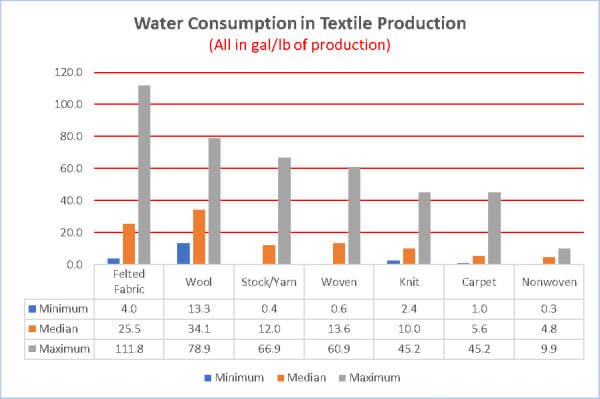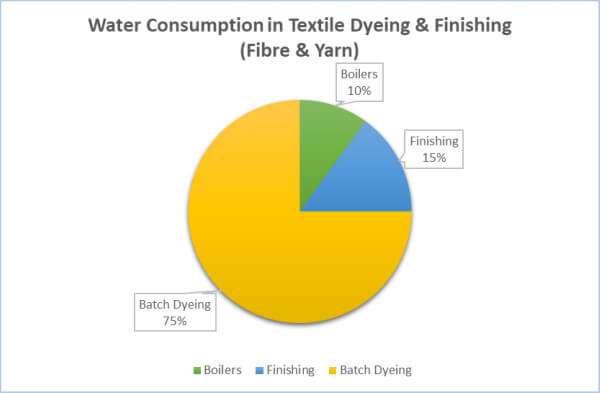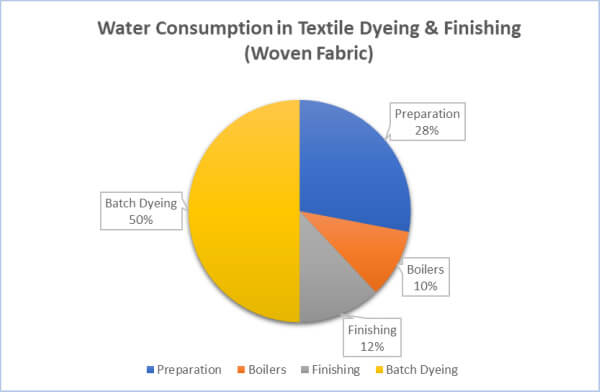Textile Wastewater Treatment: A Successful Return on Investment through Zero Liquid Discharge (ZLD) Technology
World Textile Production
Food, Clothing and Shelter are considered vital necessities of human life in general. Clothing stands second in importance of these essential commodities of life and Mankind has started using clothing from time immemorial. Science has led to many inventions of new form of fabric other than the common plant-and-animal- based fabric. Apart from clothing needs, textile products have found new uses in industrial, military, space and medical applications.
It is to be noted that textile industry handles fibres of different origins and types (Polyester, Cotton, Silk, Hemp, Flax, Wool, Rayon and Acetate), which are represented in the chart below (World Textile Fibre Average Production).

Any typical textile industry whatever form of fibre it uses, the following are the primary production processes. They are Spinning, Weaving, Dyeing, Printing, Finishing, and Garments Making. All of these production processes generate a significant amount of waste – in the form of solids, liquids and emissions. It is necessary to treat the generated waste to safeguard the environment and for compliance to the laws of the land. There is no one method to treat all the waste as the waste generated are of different types at various process steps in textile production.
Textile Production and Water Consumption
It is no harm to say that without water most of the textile production processes cannot be operated – Water is a major component utilized. The chart below (Water Consumption in Textile production) captures the percentage of water utilized in the production of different type of material.

In all of the textile production process, most significant amount of water is consumed in textile dyeing & finishing process. The two charts below represent the approximate percentage of water utilized in a typical textile dyeing & finishing processes, both for fibre & yarn and for woven fabric.


Textile Wastewater
Both the dry and wet processes of any textile production consume large amount of chemicals to facilitate the desired results. The presence of natural impurities in the fibres and the volume and the type of chemicals used in the production processes poses multiple challenges in treating textile wastewater. Hence it is essential to deploy a greater understanding of the textile chemistry, the characteristics of the textile wastewater of a process or a textile factory and the suitable solutions to treat the textile wastewater at hand.
A careful design, fabrication, erection and commissioning of textile wastewater management facility acts as a catalyst not only to meet the stringent environmental norms but to save production process costs, waste water management cost and also contributes to the recovery of both chemicals and water for reuse in the textile production processes. Thus, a successful commissioning and operating of Zero Liquid Discharge (ZLD) Plant helps in getting the return on investment over a period of time.
Characteristics of a Composite Textile Wastewater
Different processes of a textile production factory contribute a wide variety of characteristics to the textile wastewater stream. The different characteristics of a typical combined textile wastewater are: high temperature of the waste water, undesirable pH levels, suspended solids, dissolved solids, dissolved fixed solids, starch, chloride, Biological Oxygen Demand, Chemical Oxygen Demand, Chromium, Zinc, Sodium, Phenolic substances, oils & Grease, etc.
It is also essential to understand the types of main pollutants by each textile production process.
- SIZING: Starch, polyvinyl alcohol, carboxy methyl cellulose
- DESIZING: Starch, polyvinyl alcohol, carboxy methyl cellulose, wax and grease
- SCOURING: Wax, Grease, fragments of textile material, caustic soda, soda ash, surfactants, soaps, sodium silicate, antistatic lubricants, tetra sodium pyrophosphate,
- BLEACHING: Free chlorine, sodium hypochlorite, sodium peroxide, sodium chlorite, hydrogen peroxide, esters, levelling agents, softeners, Peracetic acid, alkalis and acids
- DYEING: Dye traces, mordants, sulphides, hydrosulfide and acetic acid
- PRINTING: Dye traces, gums, starch, solvents
- FINISHING: Starch, tallow, sodium chloride, sodium sulfate
RECOVER AND REUSE: IMPROVE YOUR ROI
It is right to say that textile wastewater can be considered a useful resource as with proper technology we can recover sizes, dyes, chemicals and water. A highly advanced Zero Liquid Discharge takes care of every single drop in the wastewater stream at different treatment stages to ensure proper recovery of chemicals and water. A much-advanced treatment system can recover the following:
- PVA can be recovered and be reused in sizing operations again.
- Carboxy methyl cellulose can be recovered and reused in sizing and desizing.
- Interpolymers of vinyl esters can be recovered and be reused in sizing operations.
- Caustic soda can be recovered
- Vat dyes can be recovered and be reused in dyeing process
- Glucose can be recovered from desizing wastewater
- Recovery of pectins and waxes is also feasible and economical.
- Lanolin and soap can be recovered from wool grease
- Zinc can be recovered from viscose processing wastewater
When the above chemicals are recovered and reused in the textile production process, it significantly saves chemical expenditure. It also reduces the pollutant load on the wastewater stream which significantly reduces the cost of treatment of the wastewater. Moreover, the recovered water contributes to huge savings on the cost of the process water required at every textile production stage.
Zero Liquid Discharge Treatment (ZLD)
Zero Liquid Discharge technology (ZLD) is a complex technological framework that needs an expert design by taking into the considerations of all the composite textile wastewater chemistry. A well designed and efficiently operated Zero Liquid Discharge (ZLD) Treatment Plant can handle any type of wastewater chemical or biological composition and variability in wastewater flow; can recover more than 96% of the water for reuse; recover valuable salts for reuse or repurposing; and leaves just a solid dry cake for disposal. A typical Zero liquid Discharge Treatment Plant involves:
- Clarifier
- Chemical Doser
- Filter Press
- Ultrafiltration (UF)
- Reverse Osmosis (RO)
- Brine Concentrators
- Evaporator
- Crystallizer
For some textile wastewater streams, more technological components might be added based on the individual requirements. Zero Liquid Discharge (ZLD) has come to stay as a viable and reliable wastewater treatment technology to meet stringent environmental regulations and to monetize the precious salts and water available in the textile wastewater stream.



